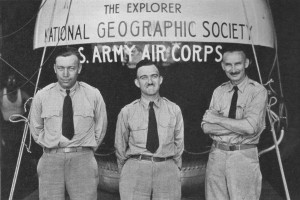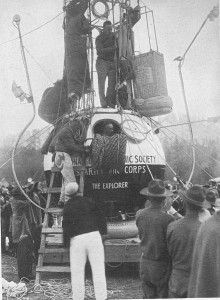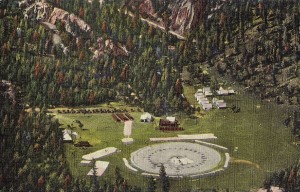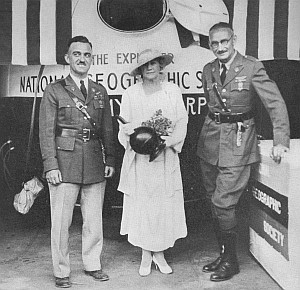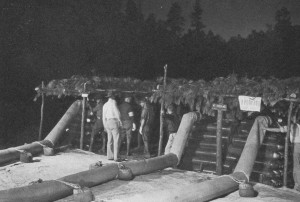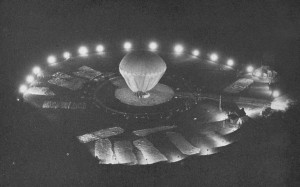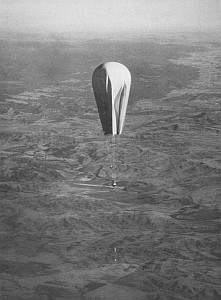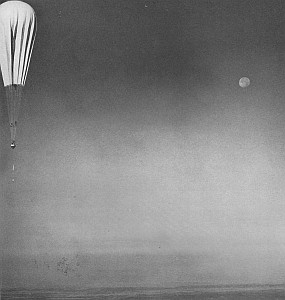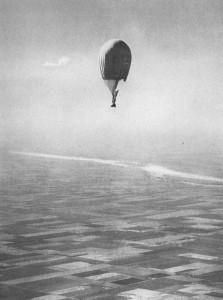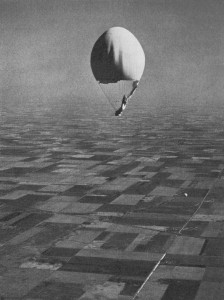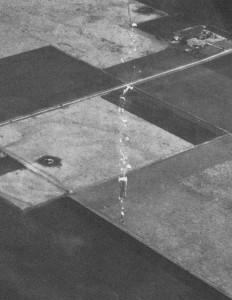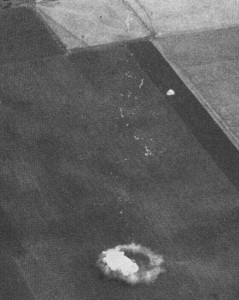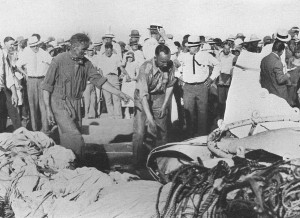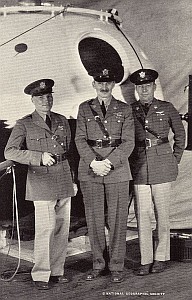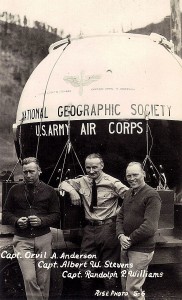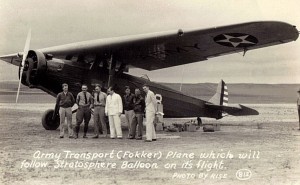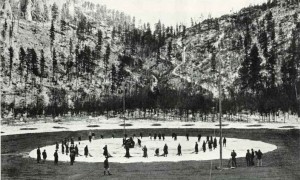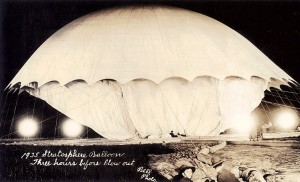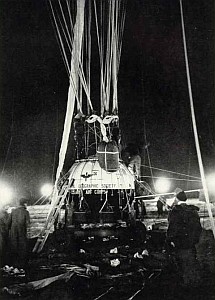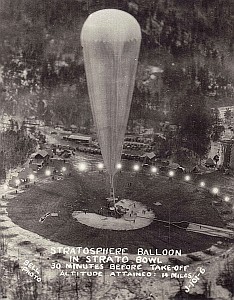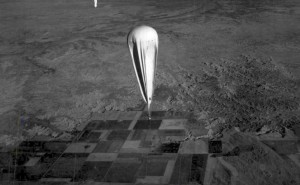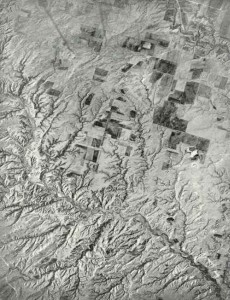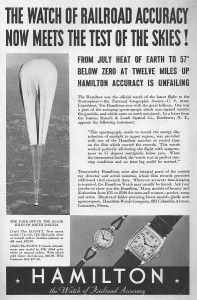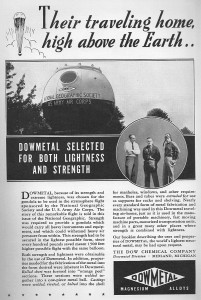On November 11, 1935, US Army Air Corps Captains Orvil A. Anderson and Albert W. Stevens reached an altitude of 72,395 feet in a pressurized gondola suspended from a 192-foot diameter helium filled balloon.
Cosmic Radiation
In the early 20th Century, scientists were very limited in the tools they had to unlock the secrets of the atom. There were no reactors, cyclotrons or particle accelerators. Antoine Henri Becquerel accidentally discovered radiation in 1896 when he left a piece of uranium on a photographic plate. When the plate was developed, Becquerel noted that the plate was fogged where the uranium had been. Two years later, Marie and Pierre Curie deduced that radiation was a phenomenon associated with atoms. Physicists soon observed that radiation was all around us, but its source remained a mystery.
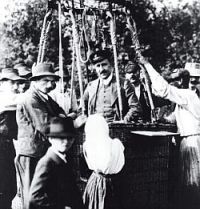
Austrian physicist Victor Franz Hess began a series of experiments in 1911 to probe the nature of this mysterious radiation. Most scientists initially believed the radiation came from the Earth itself. Then, measurements taken at a wide range of locations including caves led to the theory that the radiation was in the air. The logical extension of this theory was that as one ascended, with less air around you, there should be less radiation. Hess wondered how far one had to move away from the surface of the Earth to escape this radiation. Hess collected measurements from the top of the Eiffel Tower, which was 300 meters (1,000 feet) above the ground, then from altitudes of 1 kilometer and 5 kilometers (0.6 and 3.1 miles, respectively). To everyone's astonishment, Hess found the radiation increased with altitude - at 5 kilometers, it was several times what was observed at ground level.
Hess' results forced scientists to alter their theories as to the source of this radiation and most agreed it likely came from the sun. Then Hess performed another experiment, measuring radiation levels during a partial solar eclipse on April 12, 1912. When the radiation levels didn't change, Hess ruled out the sun as the source. Hess postulated the radiation came from outer space.
American physicist Robert Millikan initially disputed Hess' results. Millikan launched instruments on unmanned balloons to altitudes as high as 50,000 feet in 1922 and measured different radiation levels than Hess had reported, but wide temperature variations affected his results. Millikan subsequently conducted a series of experiments in mountain lakes and found the radiation decreased as one went deeper into the water. This convinced Millikan that Hess had been correct and the radiation came from beyond the earth's atmosphere. Millikan coined the term "cosmic rays" to describe the phenomenon.
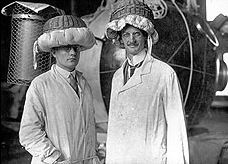
Many scientists came to believe that cosmic rays (also called cosmic radiation) held the key to unlocking the secrets of the atom. If these secrets could be coaxed out of streams of energy that bombarded our planet from space, atomic energy could be harnessed to provide a limitless potential as a new source of power for a variety of applications. Balloons offered the best platform for the study of cosmic rays. At the time, balloons could fly higher and remain aloft longer than airplanes. They could also carry entire laboratories into the sky. During the 1920s and 30s, teams of scientists and adventurers mounted several expeditions into the stratosphere.
Auguste Piccard was the first to use a pressurized gondola to carry a laboratory aloft to study cosmic radiation. On May 27, 1931, Piccard and his assistant Paul Kipfer reached 51,775 feet in a balloon launched from Augsburg, Germany. Professor Piccard returned to the stratosphere the following year with a flight to 54,120 feet. Over the next two years, others followed Piccard's example. The Russians staged two stratospheric expeditions in 1933 and 1934, as did the Chicago World's Fair, A Century of Progress, in 1933.
Explorer I
During 1933, United States Army Air Corps Captain Albert W. Stevens began pressing his superiors to mount a stratosphere expedition using a balloon. While the Army eventually endorsed the notion, the service could not provide any funding. Army support would be limited to the use of personnel and facilities. He turned to the one organization he felt would have both the willingness and means to support such an undertaking - the National Geographic Society. Stevens presented the flight as an opportunity to loft a fully equipped scientific laboratory for the study of high altitude photography techniques, properties of the upper atmosphere and cosmic radiation. It would also establish a new altitude record, perhaps as high as 75,000 feet.
Society President Gilbert Grosvenor embraced the expedition and provided most of the financial support. Other supporters for the flight included United Aircraft and Transport Corporation, Eastman Kodak Research Laboratory, Fairchild Aviation Corporation, and the Sperry Gyroscope Company. Stevens even donated several thousand dollars of his own money to support the flight.
The Army Air Corps appointed a three-man crew: Major William E. Kepner, pilot; First Lieutenant Orvil A. Anderson, alternate pilot; and Captain Stevens as scientific observer. When the expedition was first announced to Society members in the April 1934 issue of The National Geographic Magazine, the crew comprised Kepner and Stevens. Anderson subsequently became a full-fledged member of the flight crew, going from alternate to co-pilot. (He was also promoted to the rank of Captain.) The initial announcement indicated the flight would occur in June, with a follow-up flight in September to "check observations under similar conditions." Officially named The National Geographic - Army Air Corps Stratosphere Expedition, it is generally known by the name Explorer.
Explorer carried full size laboratory instruments to ensure the greatest attainable accuracy. With a crew of three, this meant Explorer would be somewhat crowded despite its eight-foot, four-inch diameter. Dow Chemical Company in Midland, Michigan built the capsule from Dowmetal, the same magnesium alloy used for A Century of Progress. Drawing upon experience of previous gondolas, the upper half of the sphere was painted white to reflect the sun's heat; the lower half was black to absorb heat from the earth. Six three-inch diameter windows made from double-pane Pyrex glass were arranged around the gondola. One of these was in the top of the capsule so they could look at the balloon during their flight.
To reach the desired altitude, Explorer needed a truly gigantic balloon; one with a volume of 3 million cubic feet. The Goodyear-Zeppelin Company assembled the balloon in Akron, Ohio. The balloon required 2,5 acres of cotton fabric, which arrived on 130 rolls that were 42,5 inches wide and 300 feet long. Warwick Mills in New Hampshire provided the fabric. Transforming rolls of flat fabric into a 178-foot diameter inflatable sphere was no small task. The material had to be cut into 3,320 major pieces, each of which had to be passed through a rubberizing machine 30 times. To ensure the airtightness of the finished envelope, it was fabricated without stitches - all the pieces were glued together. This consumed more than 300 gallons of cement made from pure rubber dissolved in gasoline and benzol. To reinforce the seams, each one had to be covered on both sides with fabric-backed rubber tape.
Even the building where the balloon was built took special preparation. The seams around the windows were sealed and the air in the building was pumped through flannel filters to remove dust. Workers wore special cloth slippers to protect the fabric. The finished balloon weighed an incredible 5,000 pounds.
A reinforced section called the catenary band girded the balloon about a third of the way from the base. When the balloon was fully inflated to its 178-foot diameter, the band became a belt around the lower third of the envelope. The catenary band had attachment points for 160 ropes, which extended to the load ring. The gondola hung from the load ring via ten ropes. Explorer used two different weights of fabric. The fabric above the catenary band weighed three ounces per square yard; the envelope below the band did not support the weight of the gondola so it used a fabric weighing two ounces per square yard.
While the balloon and gondola were being built, Kepner and Anderson searched for a launch site. They eventually found a spot in the Black Hills of South Dakota, about 12 miles southwest of Rapid City. The launch site was a grassy meadow 600 feet square in a natural depression surrounded by steep cliffs. It subsequently became known as the Stratobowl. Launching a balloon the size of the Explorer required a sheltered site because such a balloon could easily whip around like a sail if caught by the wind. Several hundred feet deep, the Stratobowl offered the needed protection from surface winds. Prevailing winds would carry the balloon over the midwestern plains for a landing in relatively flat, clear terrain. Historical data indicated they would likely have three or four opportunities for ideal weather from mid-June to mid-July.
Early in June, personnel began arriving in the area and established the Stratosphere Flight Camp, which came to be known simply as the Stratocamp. Anderson directed the growth of the Stratocamp from its creation to a community of more than a hundred people with its own drainage system, sawdust-covered streets, parking areas, sewage disposal plant, electric lighting systems, waterworks, and a hospital with an ambulance. Log cabins, utility buildings, and tents popped up as the camp grew. The Stratocamp even had its own fire department with two professional fire fighters, a pump truck, a dozen fire extinguishers, and a crew of volunteers. Having a fire department on site was particularly important since the Explorer balloon used highly flammable hydrogen gas for lift. The Rapid City Chamber of Commerce supported most of the development at the encampment, including railings around the rim of the Stratobowl for the anticipated crowds of spectators.
The Stratocamp attracted numerous visitors. These included the wife of the Governor of South Dakota and residents from the nearby Sioux reservation who toured the site while wearing traditional Native American garb. Mrs. Berry, the governor's wife, "christened" the gondola by pouring liquid oxygen over it (image at left)
A detail of 120 soldiers from the Fourth Cavalry at Fort Meade, in Sturgis, South Dakota, assisted at the Stratocamp. Although they had no previous balloon experience, they comprised the ground crew for Explorer and learned the art of handling large aerostats by launching a 35,000 cubic foot test balloon. Because they were only needed for the actual launch, the soldiers did not stay in the Stratocamp; rather, they were bussed to the launch site when needed.
The South Dakota National Guard also supported Explorer. Filling the mammoth balloon took 1,500 cylinders of hydrogen gas that were delivered via railroad to Rapid City. The South Dakota National Guard provided a convoy of 42 trucks and drivers to transport the cylinders from Rapid City to the Stratocamp. Each cylinder held 190 cubic feet of gas and weighed 131 pounds. The cylinders were stacked along one side of the launch site. The soldiers erected a canopy of pine boughs over the cylinders to shade and protect them from the heat of the sun.
The actual launch site was a 200-foot diameter circle in the center of the Stratobowl. It was covered with a 4-inch thick layer of sawdust to protect the balloon during inflation. Since a great deal of work would take place during the night before the launch, a ring of searchlights circled the launch site.
One of the high points of the preparations came on the day the gondola arrived on a truck from the Dow Chemical Company plant in Midland, Michigan. It was immediately installed in the Gondola House, which served as storage shed and workshop for the sphere. Several days later another truck arrived from Akron, Ohio, carrying the balloon. It was packed in a waterproof box and was deposited in the center of the sawdust circle. A canvas tent erected over the box provided further protection from the elements. Equipment continued to pour in, including an Army Air Corps liquid oxygen generator. Other items delivered to the Stratocamp ranged from mundane equipment like machine tools to delicate instruments and electronic apparatus needed to outfit the gondola.
By July 9, everything was ready for the flight and Kepner, Anderson, and Stevens could have taken off at any time. All they had to do was wait for favorable weather. Because aerial photography was one of the primary goals of the flight, they needed particularly clear skies, not only over the Stratobowl, but also along the projected track of the flight. Each morning and night, Major Kepner checked the latest weather maps and forecasts with the team of meteorologists. Mr. V. E. Jakl of the Weather Bureau office in Kansas City headed the meteorological team. The Stratocamp boasted one of the best-equipped weather stations in the country and received reports from stations as far away as Alaska, Iceland, and Cuba. The station was set up with the cooperation of the U. S. Weather Bureau, the Army Signal Corps, and the Army Air Corps.
Kepner watched and waited for the ideal conditions for more than two weeks. He and his crewmates spent their days in the Gondola House testing and fine-tuning the equipment aboard Explorer. On the morning of July 27, Kepner determined the weather conditions would be right for a flight the next day. A large high-pressure area drifting in from the west promised clear skies along the flight path. At noon, Kepner announced his decision. The Stratocamp became a beehive of activity as everyone made the final preparations for the flight. From that time on, only essential personnel were allowed in the launch area.
The troops from the Fourth Cavalry carefully removed the balloon from its packing crate and laid it out within the sawdust-covered launch bed. To make the balloon easier to handle prior to inflation, the fabric below the catenary band had been inverted and folded back into the main body of the envelope. While the troopers laid out the balloon, scientists inside the Gondola House checked their instruments one last time, installed batteries in Explorer, and filled its liquid oxygen bottles.
A little past dusk, the ground crew began inflating the balloon, a process that took six hours. As with much of the preliminary work, Anderson directed the crews while they piped hydrogen to the balloon through a series of canvas tubes. By two o'clock in the morning, the inflation was complete. The balloon held 210,000 cubic feet of highly flammable hydrogen gas. As the Explorer ascended, the hydrogen would expand and fully inflate the 3,000,000 cubic foot envelope at 65,000 feet.
The gondola was wheeled out of its shed and brought into position beneath the balloon. Attaching the capsule to the gasbag took nearly three hours. A little past five o'clock everything was nearly ready. After loading warm flying clothing, a small sack of mail, and their personal parachutes, Anderson and Stevens climbed into the gondola. Kepner clambered to the top of the gondola, among its rigging, where he could direct the final ground preparations. At 5:45 AM, Kepner gave the command "Cast off!" and Explorer took off.
Climbing quickly, the crew surveyed the ground beneath them. For miles around, they saw hundreds of cars and thousands of people who'd come to the Stratobowl to witness the ascent. Anderson joined Kepner on top of the gondola. Explorer was climbing too rapidly and they had to slow it down. They needed to release some of the hydrogen through the vent at the top of the balloon.
There were two means of venting hydrogen. Unlike previous high-altitude balloons that used rope-controlled vent valves, Explorer had a pneumatic valve, that could be controlled from inside the cabin. A simple tube that carried compressed air to activate the valve extended up through the inside of the balloon from the gondola. As a backup to the pneumatic valve, Explorer still had a rope-controlled valve, but it was relegated to emergency purposes and could only be actuated from outside the cabin.
Unsure of how the immense balloon would respond, Kepner and Anderson took the rope that controlled the emergency vent valve in their hands. They called to Stevens inside the gondola to open the pneumatic valve. They found the pneumatic valve worked properly and soon had the ascent under control. Anderson rejoined Stevens inside Explorer and they halted the ascension at 15,000 feet.
Stevens climbed out of the hatch and joined Kepner on top of the gondola. Working together, they lowered the 125-pound spectrograph on a 500-foot long quarter-inch rope. This task took nearly half an hour. This instrument recorded the spectrum of the sun as Explorer climbed into the atmosphere. These recordings provided information on the nature of the ozone layer of the atmosphere. With the spectrograph suspended 500 feet below the capsule, Kepner and Stevens climbed back inside and secured the hatch.
The National Broadcasting Company (NBC) provided a lightweight radio set for Explorer. While the balloon floated at 15,000 feet, the crew established contact with Washington, D. C. NBC carried their broadcasts live across its network of stations, giving radio audiences a sense of connection with the flight. Anderson dropped 400 pounds of lead shot ballast and Explorer began climbing again. They halted at 40,000 feet to conduct instrument readings. Explorer carried an array of Geiger counters arranged to determine the direction of cosmic rays. On the ground, the counters registered one or two "hits" per minute. At 40,000 feet, the rhythm was much faster. After an hour and a half, they began climbing to 60,000 feet. It was nearly noon - Explorer had been aloft for six hours.
An hour later the balloon reached the 60,000-foot level. So far, everything was going according to plan. Kepner and Anderson controlled the balloon while Stevens transmitted instrument readings to the ground. The Geiger counters sounded like "many typewriters in a newspaper office" or "like a flock of chickens pecking grain from a metal pan." Inside the gondola, it was 42º Fahrenheit despite an outside temperature of 80 degrees below zero.
Suddenly there was a clattering on the top of the gondola.
Looking through the three-inch diameter window above the hatch, the aeronauts saw part of the rope connected to the balloon appendix had fallen. The appendix was an open sleeve at the base of the balloon. Once they were at 63,000 feet and the balloon fully inflated, excess hydrogen vented through the appendix. Further examination soon showed why the rope fell - there was a large rip in the base of the balloon!
The rubber compound used to coat the balloon fabric left it slightly sticky. To keep the fabric from sticking together, it was dusted with a layer of powder. Unfortunately, this did not prevent adhesions, particularly when the lower portion of the balloon was folded inside the upper portion prior to launch. This put a lot of stress on the two-ounce fabric, which tore as the balloon approached full inflation.
Kepner, Anderson, and Stevens quickly decided against trying to go any higher. They opened the pneumatic valve to vent hydrogen. However, the sun was heating the balloon and made the gas expand. They continued to rise for another twenty minutes, eventually reaching 60,613 feet. Despite their situation, Anderson and Stevens took time to collect samples of the air at 60,000 feet. Kepner stood by with his hand on the lever that would release the 80-foot diameter emergency parachute. Finally, Explorer began to descend.
Within 45 minutes, they were down to 40,000 feet. Inside the gondola, Kepner, Anderson, and Stevens could hear the balloon fabric tearing. Another 30 minutes passed and their altitude was just 20,000 feet. Throughout the flight, they wore parachute harnesses. Now they clipped their emergency parachutes to the harnesses. Working quickly, they opened the hatch and climbed on top of the gondola to inspect the balloon. Large tears appeared in the lower part. Suddenly the entire bottom of the bag dropped out.
What had been a balloon became a parachute filled with a mixture of hydrogen and air. They dropped rapidly. Stevens dumped ballast overboard as Anderson and Kepner released the heavy spectrograph, which was on a parachute. By 10,000 feet, the descent rate still hadn't slowed. Throughout the descent, the crew kept up their radio transmissions, sharing the drama with audiences around the world.
Barely half a mile above the ground they abandoned the craft, relying on their personal parachutes for landing. Anderson tried to jump first, but his parachute container caught on the rigging, spilling his canopy. He gathered the fabric under one arm and prepared to jump. While gathering the fabric, he slipped and had both feet inside the open hatch. "Hey, get your big feet out of the way! I want to jump!" yelled Stevens, who was still inside the gondola. Just as Anderson cleared the hatch the hydrogen that remained in the balloon exploded and the capsule plummeted like a stone. Bellow can be seen a sequence of images taken from the chase plane from the moment of the balloon's rupture to the instant of the gondola impact as were published in the National Geographic Magazine.
Pieces of the disintegrating balloon landed on top of Anderson's parachute and at first it looked like they would collapse the canopy. Fortunately, the pieces slid off and his descent continued safely. Stevens tried twice to get out of the gondola but the windblast forced him back. On the third try, Kepner pushed him with his boot as he lunged through the hatch. Stevens found the capsule fell at the same rate of speed as he did, so he was not falling away from it. He turned over in freefall and pulled the ripcord. His parachute opened immediately and checked his fall. Major Kepner was last to jump, opening his parachute only seconds before the capsule hit the earth with a terrific thud in a cornfield owned by Mr. Reuben Johnson near Holdrege, Nebraska.
All three pilots landed nearby, shaken but safe. Hundreds of people streamed toward the impact point after chasing the balloon in their cars across the Nebraska prairie. The chase plane, piloted by Lieutenant J. F. Phillips landed in an adjacent field. Everyone -aeronauts, airplane crew, and spectators- pitched in and helped gather wreckage, although many spectators collected pieces of balloon fabric as souvenirs. Kepner and Stevens walked to the Johnson farmhouse and asked to use the telephone.
At first, it looked as though the flight was a total loss from the scientific standpoint. Most instruments, particularly the electroscopes used to gauge cosmic rays, were smashed. The film magazines from the aerial cameras appeared to be likewise destroyed. However, the barographs that provided official recordings of the altitude survived with barely a scratch. Of course, the spectrograph that had been jettisoned during the descent was recovered intact. Although everyone expected the film records to be ruined, photographic technicians developed them anyway. When they did this, they discovered that most of the film recordings of the instruments and ground miraculously survived. Of 200 exposures made during the flight, 163 yielded usable prints.
Kepner, Anderson, and Stevens each received the Distinguished Flying Cross from the Secretary of War for the flight. Despite the loss of the capsule and the near loss of the crew, enough experimental data was recovered so that, from a scientific standpoint, the flight was considered a success. Fortunately, Society President Grosvenor insured the flight through Lloyd's of London. Lloyd's paid $30,170 on the policies that covered the balloon, gondola, and instruments. The Army and the National Geographic Society began planning another flight.
Explorer II
In the February 1935 issue of The National Geographic Magazine, Society President Gilbert Grosvenor announced there would be another Explorer flight. Like the first flight, this one would be jointly sponsored with the Army Air Corps. The Air Corps appointed three officers as the flight crew. Captain Anderson was the mission commander, Captain Stevens was pilot and scientific observer, and Captain Randolph P. Williams was appointed alternate pilot. Major Kepner was unavailable because he'd been appointed to the Air Corps Tactical School. (Kepner eventually reached the rank of Lieutenant General. During World War II, he commanded the 8th Fighter Command in the European Theater at the time of the D-Day invasion. In the closing months of the war, he commanded the 9th Air Force.)
The June issue of The National Geographic Magazine carried further details about the upcoming expedition to the stratosphere and announced the flight would be named Explorer II. To avoid the chance of an explosion like the one that occurred during the first Explorer flight, this balloon would use helium. While this enhanced the overall safety of the flight, it meant that Explorer II needed a larger balloon than its predecessor because helium only has 92% of the lifting capacity of hydrogen.
The Explorer II balloon was bigger than any one previously built, with a volume of 3.7 million cubic feet. It weighed 6,500 pounds. Goodyear-Zeppelin built the balloon in Akron, Ohio. Karl Arnstein led the team that designed and built the balloon. Fully inflated, the balloon had a diameter of 192 feet. The Wellington Sears Company provided the balloon fabric - cotton cloth weighing 4 ounces per square yard for the upper portion of the envelope and 3-ounce fabric for the lower portion. When coated with rubber, the upper fabric weighed 7.2 ounces per square yard; the lower portions increased to 5.3 ounces. Otherwise, the construction techniques were similar for the larger bag as they were for the first Explorer. Prior to launch, the aerostat would tower 315 feet above the ground.
Dow Chemical built the Explorer II gondola from Dowmetal. The Explorer II capsule was much roomier than its predecessor; it was nine feet in diameter. Like the first Explorer, the gondola was painted black on the lower half and white on top. Explorer II sported a 14-foot arm with a fan that would presumably rotate the aerostat as it floated at altitude so that cosmic radiation instruments could collect observations pointing in different directions. The empty sphere with its hatch covers and arm weighed 638 pounds. This was considerably lighter than the smaller Explorer I capsule, which weighed 700 pounds. Improvements in "secondary details" like the size and location of hatches, method of suspension to the balloon, and removal of shelving inside the capsule made the weight savings possible. Captain Stevens preferred to bolt instruments directly to the wall of the gondola rather than place them on shelves. This not only saved weight, but it provided a more efficient use of space inside the capsule.
Explorer II used the same ballast release system as Jean Piccard created for his flight with the A Century of Progress gondola. Forty bags of ballast, each one loaded with 75 pounds of lead shot, were attached directly to the load ring and hung around the exterior of the gondola. Anderson and Stevens also had several bags of ballast inside the capsule that they could dump overboard when the hatch was open. Mounting the ballast sacks to the load ring meant it could be attached directly to the gondola shell. This proved to be lighter than the way it had been done on the first Explorer. The batteries that powered the equipment aboard Explorer II weighed in at nearly 1,000 pounds. They were arranged around the exterior of the gondola and could be released (with individual parachutes, of course) as ballast during landing.
Stevens designed the life support, or "air conditioning" system (as it was called at the time). He used a mixture of 46% liquid oxygen and 54% liquid nitrogen to replenish the cabin atmosphere. The liquefied gas mixture passed through a copper expansion coil, where it vaporized. Pressurized helium gas forced the oxygen/nitrogen mixture out of its storage container into the coil. A sylphon-type regulating valve designed by Stevens and Mr. Oscar Steiner admitted gas to the cabin as needed to maintain atmospheric pressure.
The expansion coil was housed in the top of a cabinet that held cloth bags of sodium hydroxide pellets. A circulating fan forced air over the coil and through the cloth sacks. The sodium hydroxide pellets removed carbon dioxide from the atmosphere. Sodium hydroxide also readily absorbs moisture. As the air conditioning unit scrubbed both deadly carbon dioxide and unwanted excess moisture from the atmosphere, the result was a solution of sodium carbonate and water that was absorbed by a layer of sawdust in the bottom of the cabinet.
At launch, Explorer II carried a 53-pound supply of liquefied oxygen and nitrogen in a 25-liter insulated flask. Stevens and Anderson also had a reserve supply of 32.5 pounds of a 50/50 oxygen/nitrogen mixture in case a leak occurred in the gondola.
By spring 1935, the second Army Air Corps/National Geographic Society Explorer flight was ready. Anderson and Williams conducted two test flights with an 80,000-cubic foot balloon on April 21st and 28th. Flying in an open basket, they reached 25,000 feet and 24,500 feet, respectively. During these flights, they tested the air-conductivity apparatus that would be carried on Explorer II, and observed the effects of dropping ballast on the instrument.
In May, camp was again established at the Stratobowl. Meteorological personnel were among the first to arrive. They reported to the site between May 6th and 10th. For the next two months, activities proceeded much as they had for the first Explorer flight. Troops from Fort Meade were again called upon to be the ground crew.
Throughout June, everyone waited for suitable weather for the flight. Because of his background and training, Captain Williams was in charge of the meteorological station. Criteria for the flight were very strict. Surface winds at the Stratobowl could not exceed 4 miles per hour, skies over the flight path had to be clear, and winds at the landing site had to be less than 14 miles per hour. June passed without the right conditions for a flight. Finally, on July 10, Williams observed the formation of a large, dry, Polar air mass that created the needed high-pressure area. He tracked the mass as it headed for Rapid City. At noon on July 11, conditions were ideal for a flight the next day. Skies were clear and winds were calm in the Stratobowl.
Balloon inflation went smoothly in the early morning hours of July 12 and the crew looked forward to a record-breaking flight. With the balloon inflated, all that remained was to wheel the gondola into position underneath the bag and attach it. The ground crew finished attaching the gondola to the balloon and began final checks before the crew boarded. Suddenly the balloon tore near its top, spilling its load of helium. In "six or seven seconds," the three-ton bag was laying on the ground. Some of the personnel were not fast enough to get out of the way and were trapped beneath nearly three acres of fabric. Fortunately, others helped them crawl out unharmed. The balloon was gathered up and shipped back to Goodyear Zeppelin.
Balloons of that time had a "rip panel" near the apex of the bag as a safety feature. When landing, the pilots pulled a rope which tore the balloon along the edges of the panel, releasing the gas and preventing the gondola from being dragged or bounced along by the wind. Explorer II's failure showed there was more stress on the rip panel in large balloons than previously thought. Unable to bear the stress, the V-shaped panel tore. Goodyear engineers designed a new system to open the bag after landing. It used a steel cable which, when pulled, would tear the fabric and release the helium in a few seconds. Goodyear repaired the balloon at no cost, installed the new rip cable and shipped it to the Stratobowl for another flight attempt.
On the afternoon of November 10, 1935, ground crews spread out a huge canvas ground cloth in the middle of the Stratobowl. The air temperature was bitterly cold, only a few degrees above zero. Finally, it was time to lay out the balloon, which had been kept in a tent heated to 50o F, so the rubberized fabric was pliable and easy to manipulate at first. It soon became stiff and difficult to unfold as it lay on the cold ground.
Working by the illumination of 36 floodlights ringing the launch area, ground crews inflated the balloon, using 1,685 cylinders of helium. Near midnight, one of the technicians noticed a "pocket" of gas forming beneath the folds of fabric near one of the inflation tubes. The unequal stress was too much. There was a gentle pop as the fabric tore. The ground crew gradually let the balloon rise as they searched for the rupture. When they found it, it was 17 feet long! Despite the bitter temperatures, they decided to patch the tear. Working quickly, the Goodyear Zeppelin Company and Army men glued a piece of balloon fabric over the hole. They used a 1,500-watt light bulb and a reflector to warm the repair and cure the glue. With the repair finished, they resumed inflating the balloon. Amazingly, finding and repairing the tear only put them a little more than an hour and a half behind schedule.
Lift off occurred at 7:01 a.m., Mountain Standard Time, on November 11. Hundreds of people gathered around the top of the Stratobowl to watch the ascent. The capsule had just cleared the walls of the bowl when the balloon began dropping. Anderson was outside the gondola; Stevens was inside. Anderson climbed through the open porthole and announced "I believe the balloon is leaking!" Fearing a crash, they dropped 750 pounds of lead shot ballast.
To observers on the ground, it looked like streams of water pouring out of the capsule. Most of those beneath the lead shower scattered. One unfortunate gentleman got caught in the middle of the stream and was covered with fine lead shot. Lighter, Explorer II again ascended over the South Dakota Badlands. There was no leak; the balloon simply encountered a strong down draft as it cleared the rim. The pilots clambered outside the capsule, amongst the rigging throughout much of the early ascent. When they reached 16,000 feet, they climbed into the sphere and sealed the hatch. Testing the capsule for leaks, they pressurized the cabin to the equivalent of 13,000 feet. They maintained this pressure throughout the flight.
During the climb, temperatures inside Explorer dropped to 21o F. Anderson tried to eat a sandwich, but he discovered it had frozen. Actually, both he and Stevens were so busy that they weren't particularly hungry, so Anderson placed the sandwich on top of one of the instrument cabinets and quickly forgot about it. They were very thirsty, however, and drank hot water from a gallon container. Anticipating cold temperatures aloft, they carried three containers of hot water with them.
At first, the winds carried them southeast, towards Pine Ridge and the border with Nebraska. Around 40,000 feet, the winds shifted and Explorer II began following a more easterly track. Three hours and 29 minutes after launch, Anderson and Stevens reached 65,000 feet. The balloon was inflated to its full 192-foot diameter. Anderson dropped ballast, gently coaxing the balloon higher. At 11:40 a.m., Explorer II settled out at 72,395 feet. They were above 96% of the atmosphere, higher than anyone had ever ventured. The temperature inside the gondola climbed to 43o.
From such a great height, Stevens reported they saw mostly patches of green or brown on the ground. Railroads were the only recognizable features, and then only by an occasional cut or fill. Larger farms could be picked out by their rectangular patterns. A new American flag hung from the rigging. The sky above them was a darker blue than that on the flag. They recorded the first photographs that showed the curved top of the troposphere and the curvature of the Earth. Anderson and Stevens calculated they could drop another ton of ballast and gain another 2,000 feet, but decided not to. They had to conserve their remaining ballast to guard against a crash landing.
Around noon, they began their descent. Once Stevens was sure they were on the way down, he dropped a device that would collect airborne spores down to an altitude of 36,000 feet. At first, the parachute did not open, but it must have, because the device was recovered intact and returned to the U. S. Department of Agriculture. Subsequent analysis revealed ten types of spores, bacteria, and fungi had been collected. This was considered important because this was the first time that living spores had been found above 36,000 feet in the atmosphere. When they began their descent, the pilots collected samples of the rarefied air for later analysis.
Explorer II carried a cosmic ray telescope that comprised a series of Geiger Müller tubes arranged to record incoming radiation in the horizontal plane; 10o elevation; 30o elevation; 60o elevation; and vertically. The pilots were supposed to use the arm-mounted fan to turn the capsule once they were at peak altitude and obtain readings facing different azimuths.
Unfortunately, Anderson and Stevens discovered the air was too thin for the fan to turn the capsule. Despite this problem, they observed the number of cosmic rays entering the vertical telescope increased steadily up to 57,000 feet. After that, the number of recorded rays decreased. At 40,000 feet, cosmic ray intensity was 40.1 times greater than at sea level. Cosmic radiation intensity peaked at 55 times greater than sea level at an altitude of 57,000 feet. Beyond that, it fell to 42 times sea level at 72,395 feet. These changes in intensity generally agreed with data collected by Explorer I and Jean Piccard. Examining the data, Swann concluded that most of the observed radiation effects were due to "secondary rays" created when primary rays enter from space and collide with air molecules in the upper atmosphere.
Stevens and Anderson also had an instrument called a stoss chamber to record "bursts of energy" from cosmic rays striking atoms of metallic materials. The chamber comprised a 20-inch diameter sphere of Dowmetal containing nitrogen pressurized to 250 pounds per square inch. A 5/8-inch thick lead plate was placed above the chamber. Most of the time, a cosmic ray particle would pass through the shield without striking any lead atoms. Occasionally, a particle would strike a lead atom and send a shower of secondary particles into the chamber that caused a sharp increase in the ionization of the nitrogen.
Dr. W. T. Wilkins of the University of Rochester provided packages of film plates similar to those carried by Settle and Fordney on A Century of Progress. When a cosmic radiation particle hits one of the film plates, it leaves a track in the photographic emulsion. Two packages of film plates, wrapped in lightproof black paper, were attached to the outside of the gondola. In the laboratory, Wilkins observed that an alpha particle from the element Radium with an energy level of 7.7 million electron volts left a track 33 grains long. After the Explorer II flight, Wilkins discovered a track that, if made by an alpha particle, had an energy level of 100 million electron volts.
Medical scientists also used Explorer II to see what effect cosmic radiation might have on living organisms by sending Drosophila fruit flies aloft. Although they were carried inside the gondola, all of the adult flies in the package died due to the cold temperatures encountered during the flight. At first, the scientists feared the experiment would be a total loss, then they found some of the larvae and eggs survived and they ended up with 98 individuals for breeding. Subsequent results were inconclusive for any radiation-induced mutations due to the small number of flies returned.
Explorer II also carried instruments to study the sun and atmosphere. Two spectrographs obtained spectra of the sun and upper atmosphere. This latter was considered important because it measured the quantity of ozone aloft. Another set of instruments mounted outside the gondola measured sky brightness. The pilots measured the brightness of the sun and found it appeared 20% brighter at 72,395 feet than it did on the ground. Using a specially designed probe, Anderson and Stevens studied the electrical conductivity of the atmosphere above 30,000 feet. They also brought back a full photographic record of their flight, including the first color images of the stratosphere.
Throughout the flight, Stevens talked with engineers from the National Broadcasting System (NBC) who were on the ground at Rapid City. NBC provided an 8-watt radio for Explorer II. As the pilots talked, instruments could be heard in the background. Particularly audible was the rattle of an electric hammer every 90 seconds that beat on the barometer case. The case contained both mercury and aneroid barometers. Striking it with a hammer jarred the column of mercury and the aneroid needle so they wouldn't lag and improved the precision of Anderson's and Stevens' altitude measurements.
A little past 2 p.m., the Explorer II aeronauts talked directly to the Pan American Airways "China Clipper," which was flying over the Pacific Ocean en route from San Diego to San Francisco. "Hello! Calling stratospheric balloon!" came the call from W. Burke Miller of NBC and Captain Edwin C. Musick, Pan American's chief pilot, who were aboard the airliner. Then they talked with a radio announcer in London. These transmissions were broadcast live over the NBC system. The banter continued until the balloon reached 16,000 feet, where Anderson and Stevens had to open the capsule's hatches. They dumped the remaining liquid oxygen and liquid nitrogen they carried to replenish the cabin atmosphere, then dropped batteries and ballast to control the final descent. In preparation for landing, the pilots donned leather football helmets loaned to them by the Rapid City High School team.
Anderson and Stevens saw a large open field coming up and agreed it would be a good landing area. They also spotted clouds of dust raised by hundreds of cars that followed them towards their landing spot. The pilots dropped a drag rope and hollered for some of the growing crowd of spectators to grab it. No one did, so they prepared to use the rip cord as soon as they touched solid ground. Anderson called to Stevens "Make ready for landing!" Stevens scrambled across the cabin just in time to help him with the rip cord. Glancing through the porthole in the bottom of the capsule, Stevens saw they were only a foot or two off the ground. They pulled the cord, and felt the steel cable rip a hole in the top of the balloon. The pair grabbed a linen strap strung across the gondola just as the capsule touched down and rolled over on its side. They were showered with lead ballast that had been spilled in the capsule during the ascent. Stevens and Anderson climbed out to the cheers and congratulations of the crowd. Their flight had lasted 8 hours, 13 minutes, and they landed near White Lake, South Dakota, about 225 miles east of the Stratobowl.
About the author
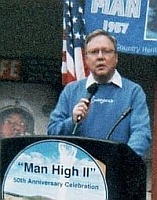
Gregory P. Kennedy is an internationally known expert in aerospace history. He has authored, co-authored, or edited eight books on space history including Touching Space: The Story of Project Manhigh, which was released by Schiffer Publishing Company of Atglen, Pennsylvania (www.schifferbooks.com).
He has also published numerous articles on the Manhigh project and recently appeared on a PBS documentary entitled "Space Men".
With nearly 40 years' experience in aviation and space museums, Mr. Kennedy has worked at the Smithsonian Institution; the Space Center; American Airlines C. R. Smith Museum; and No. 1 British Flying Training School Museum. While at the Smithsonian, he was Associate Curator for the National Air and Space Museum's collection of manned space flight artifacts.
It was during his tenure at the Smithsonian that he became fascinated with Project Manhigh and the contributions of high-altitude ballooning to space exploration. At the Space Center (currently known as the New Mexico Museum of Space History) in Alamogordo, New Mexico, Mr. Kennedy met many Project Manhigh personnel.

